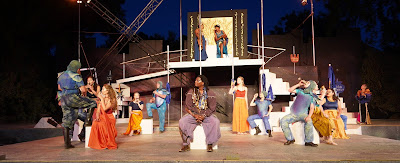What Is Art For?
 |
| Marin Shakespeare Company |
The Amphitheatre spread out in wooden plank seats under the sky before a stage flanked by a building facade with doors. It was the home of the Marin Shakespeare Company on the grounds of Dominican University which mounted two or three plays every summer. We were waiting to see Two Gentlemen of Verona.
Of course, our family project had to be laced with adventure. It took us an hour to walk over the mountain and would take us an hour to walk back in deep darkness under the stars. In places it was quite steep, and the path rocky. Don, otherwise known as Pooh for the purposes of these adventures, strode confidently ahead, though somewhat behind Jesse, who was feeling his oats! Myself, Piglet, a small and timid animal, struggled along behind. I couldn’t see very well, though I was confident in my companions.
It turned out the girls knew Jesse from his attendance at Devil’s Gulch farm camp during the summer. Farm camp was another of Don’s efforts to get Jesse doing real things with real people. It was wonderful, a diversified farm which had animals, vineyards, gardens and a creek. We once saw its owners, Mark and Myriam Pasternak with their family, come in from West Marin, below us on seats in the Amphitheatre. But that is another story.
That night, we were watching Shakespeare. Two Gentlemen of Verona told of two couples who fall in love, though in one the girl must dress as a boy and become the page of her lover, while in the other, the girl’s father will not allow his daughter to marry until she is rescued by the outlaw her lover has become. Set in a Verona of the 1960’s, Speed (played by our friend Darren Bridgett) rides in on a Vespa, a number of clowns spice up the action, and Crab, a particularly dolorous-looking basset hound, made the play fun to watch. The play is thought to be one of Shakespeare’s earliest, but done with a light hand, everyone enjoyed it.
These days no one asks what art is for. Everyone watches stories on television and in movies, goes to concerts of all kinds, and visits art galleries and museums. Street murals and graffiti are often welcomed. People want to be writers, filmmakers, singers, musicians, actors, comedians. Technology has allowed anyone to think they are a photographer, a critic, a philosopher or a musician without studying the craft involved. Celebrity status is accorded artists almost as readily as sports heroes and politicians.
The question today becomes: what is art, and what is merely pastime, entertainment? What opens us, leads us toward new knowledge of ourselves and our abilities, and what is simply the story of the status quo, a product calculated to keep us mesmerized and (crucially) opening our wallets for more? What shows us the world in all its depth and profundity and what is merely on the surface?
E. O. Wilson states the biological origin of art among humans: “The dominating influence that spawned the arts was the need to impose order on the confusion caused by intelligence … The lifetime of an individual being is not long enough to sort out experience by means of generalized, unchanneled learning … Early humans invented the arts in an attempt to express and control through magic the abundance of the environment, the power of solidarity, and other forces in their lives that mattered most to survival and reproduction.” [Consilience: The Unity of Knowledge, 1998]
One of the most powerful stories of the force for change art can be is that of Dameion Brown. The Marin Shakespeare Company provides classes in theatre arts for all, including for incarcerated people. Lesley Currier, managing director, gave a class at San Quentin prison in which Brown participated. In a Ted talk, he explains the lasting changes that came over those taking the class. On his parole after 23 years, Brown played Othello in the 2016 production at the Forest Amphitheatre. He was a sensation, and if you listen to him, you will see exactly why. Today he is an artist in residence at the company.
Shakespeare accomplished many things with his plays: he interrogated history, questioned monarchs and nobility, enriched the English language and captivated the groundlings. We visited the reconstructed Globe theatre in Southwark, London, and saw how this worked. Don, who performed as Hamlet in a high school production, and is much more of a Shakespeare scholar than I, has used Shakespeare as a mentor throughout his work as a filmmaker. Again E.O. Wilson: “The quality of the arts is measured by their humanness, by the precision of their adherence to human nature.”
Don, Jesse and I trekked over the hill to the Forest Amphitheatre for many years. So many great productions! One of the girls Jesse met that night, Kristen, became a good friend. And was it entertainment? Yes, but also a multi-faceted experience, an enrichment of our taste and sensibilities.


Comments
Post a Comment